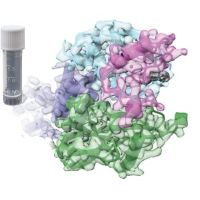Specification
| Description | Recombinant protein from the full-length sequence of Homo sapiens sestrin 2 (SESN2) (NM_031459). |
| Organism | Homo sapiens (Human) |
| Expression Host | Human Cells |
| Tag Info | His or DYKDDDDK. Please contact us if you need further information or require specific designed tag. |
| Purity | Greater than 90% by SDS-PAGE gel |
| Uniprot ID | P58004 |
| Entry Name | SESN2_HUMAN |
| Gene Names | SESN2 Hi95 SEST2 |
| Alternative Gene Names | Hi95 SEST2 |
| Alternative Protein Names | Sestrin-2 (EC 1.11.1.-) (Hypoxia-induced gene) |
| Application | Antigens, Western, ELISA and other in vitro binding or in vivo functional assays, and protein-protein interaction studies; For research & development use only! |
| Buffer | Purified protein formulated in a sterile solution of PBS buffer, pH7.2, without any preservatives |
| Endotoxin | Endotoxin level is < 0.1 ng/µg of protein (<1EU /µg) |
| Length | 480 |
| Molecular Weight(Da) | 54494 |
| Protein Sequence | (The sequence of expressed protein may have some variation from the sequence shown below. Please contact us for the exact sequence.) MIVADSECRAELKDYLRFAPGGVGDSGPGEEQRESRARRGPRGPSAFIPVEEVLREGAESLEQHLGLEALMSSGRVDNLAVVMGLHPDYFTSFWRLHYLLLHTDGPLASSWRHYIAIMAAARHQCSYLVGSHMAEFLQTGGDPEWLLGLHRAPEKLRKLSEINKLLAHRPWLITKEHIQALLKTGEHTWSLAELIQALVLLTHCHSLSSFVFGCGILPEGDADGSPAPQAPTPPSEQSSPPSRDPLNNSGGFESARDVEALMERMQQLQESLLRDEGTSQEEMESRFELEKSESLLVTPSADILEPSPHPDMLCFVEDPTFGYEDFTRRGAQAPPTFRAQDYTWEDHGYSLIQRLYPEGGQLLDEKFQAAYSLTYNTIAMHSGVDTSVLRRAIWNYIHCVFGIRYDDYDYGEVNQLLERNLKVYIKTVACYPEKTTRRMYNLFWRHFRHSEKVHVNLLLLEARMQAALLYALRAITRYMT |
Background
| Function | FUNCTION: Functions as an intracellular leucine sensor that negatively regulates the TORC1 signaling pathway through the GATOR complex. In absence of leucine, binds the GATOR subcomplex GATOR2 and prevents TORC1 signaling (PubMed:18692468, PubMed:25263562, PubMed:25457612, PubMed:26449471, PubMed:26612684, PubMed:26586190). Binding of leucine to SESN2 disrupts its interaction with GATOR2 thereby activating the TORC1 signaling pathway (PubMed:26449471, PubMed:26586190). This stress-inducible metabolic regulator also plays a role in protection against oxidative and genotoxic stresses. May negatively regulate protein translation in response to endoplasmic reticulum stress, via TORC1 (PubMed:24947615). May positively regulate the transcription by NFE2L2 of genes involved in the response to oxidative stress by facilitating the SQSTM1-mediated autophagic degradation of KEAP1 (PubMed:23274085). May also mediate TP53 inhibition of TORC1 signaling upon genotoxic stress (PubMed:18692468). Moreover, may prevent the accumulation of reactive oxygen species (ROS) through the alkylhydroperoxide reductase activity born by the N-terminal domain of the protein (PubMed:26612684). Was originally reported to contribute to oxidative stress resistance by reducing PRDX1 (PubMed:15105503). However, this could not be confirmed (PubMed:19113821). {ECO:0000269|PubMed:15105503, ECO:0000269|PubMed:18692468, ECO:0000269|PubMed:19113821, ECO:0000269|PubMed:23274085, ECO:0000269|PubMed:24947615, ECO:0000269|PubMed:25263562, ECO:0000269|PubMed:25457612, ECO:0000269|PubMed:26449471, ECO:0000269|PubMed:26586190, ECO:0000269|PubMed:26612684}. |
| Pathway | |
| Protein Families | Sestrin family |
| Tissue Specificity | Widely expressed. {ECO:0000269|PubMed:12607115}. |
QC Data
| Note | Please contact us for QC Data |
| Product Image (Reference Only) |  |

